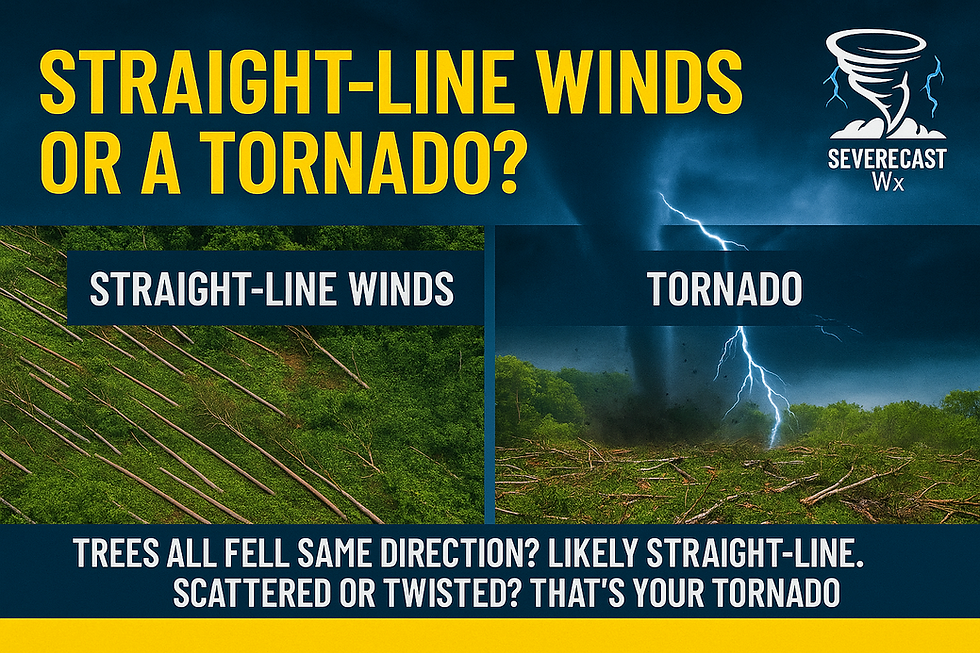St. Patrick's Weekend Outbreak March 14-16, 2025
- Nicole Carbone
- Mar 17
- 3 min read

A powerful low-pressure system moved eastward across the United States, with pressure levels comparable to a Category 2 hurricane—though, of course, no actual hurricane was present. As the system progressed, meteorological models consistently indicated a significant severe weather outbreak from March 14-16. Forecasters, meteorologists, and storm chasers closely monitored the system for over a week, though uncertainty remained until the final days before impact.
Extreme winds in the Central Plains fueled numerous wildfires, which continue to challenge the brave men and women battling them. Ahead of the front, severe storms ignited from Illinois to Louisiana, leading to two Tornado Emergencies, 31 Particularly Dangerous Situation (PDS) Tornado Warnings, and over 200 Radar-Indicated Tornado Warnings, in addition to hundreds of Severe Thunderstorm Warnings.
March 14, 2025: The First Day
Severe storms initiated in the late afternoon, transitioning into an intense nocturnal threat across the Midwest, Mississippi Valley and Dixie Alley. The outbreak resulted in widespread reports of damaging winds, large hail, and tornadoes—including one Tornado Emergency, the highest level of warning issued by the National Weather Service, reserved for catastrophic, life-threatening tornadoes.
Millions were at risk overnight, a particularly dangerous scenario as nocturnal tornadoes are difficult to see and often catch communities off guard. The scale of destruction that unfolded was devastating. The preliminary tornado count for this day stands at 57 tornadoes, with many families losing their homes, possessions, and loved ones.
March 15, 2025: The Second Day
A secondary low-pressure system developed near the Gulf of America, feeding warm, moist air into a highly unstable environment. This system, combined with the influence of the previous day’s trough, triggered widespread severe weather across Dixie Alley (Lousiana, Alabama, Arkansas, Mississippi, Georgia, and Tennessee) and the Florida Panhandle.
Severe storms erupted early in the morning, with multiple PDS Tornado Warnings issued throughout the day. Several communities endured back-to-back tornadoes, forcing residents to relive their worst fears within minutes. Emergency responders were overwhelmed, power crews mobilized across multiple states, and storm chasers assisted with search and rescue efforts.
The preliminary report for March 15 includes:
53 tornado reports
218 wind reports
29 hail reports (3 of which were large hail events)
Once again, lives were lost, homes were destroyed, and communities were forever changed.
March 16, 2025: The Final Blow
By the third day, the system had moved into the Ohio Valley, Central Pennsylvania, and New York. While this was the least destructive day of the outbreak, severe weather persisted. The storms eventually congealed into a QLCS (Squall Line), shifting the primary threat to damaging winds rather than tornadoes.
Preliminary reports for this day include:
7 tornado reports
420 wind reports (including 3 significant wind events)
36 hail reports (3 of which featured large hail)
The Aftermath: A Nation in Mourning
At least 42 people lost their lives as the weekend’s storms unleashed tornadoes, wildfires, blinding dust storms, and widespread destruction. Communities across eight states in the South and Midwest are now left to pick up the pieces.
Missouri recorded the highest number of fatalities. Along with Mississippi, Alabama, Arkansas and North Carolina due to the storms.
Oklahoma suffered multiple deaths due to wildfires and high winds.
Fatal vehicle crashes occurred in dust storms, claiming additional lives in Texas.
The Storm Prediction Center (SPC) issued numerous Mesoscale Discussions and High-Risk warnings, stating:
"Numerous significant tornadoes, some of which should be long-track and potentially violent, are expected on Saturday afternoon and evening."
As of this writing, three EF-4 tornadoes have been confirmed, impacting Kentwood, Louisiana; Larkin, Arkansas; and Diaz, Arkansas.
Leadership & Response Efforts
President Donald Trump confirmed that the White House is monitoring the crisis and pledged federal assistance to affected states. The National Guard has been deployed to Arkansas to assist with recovery and relief efforts.
A Personal Reflection
This experience has reinforced an essential truth:
Never underestimate the power of weather.
I worked for 72 hours straight with the help of Renee Cole doing overnight, coordinating with Emergency Management agencies and working closely with my partner agency, Rescue 136 Mutual Aid. Our team deployed personnel to the hardest-hit areas, issued real-time alerts, and ensured the safety of those in the field. It was an exhausting and emotionally draining operation—but the strength of the people and the resilience of the community kept us going.
Even in the face of such devastation, the kindness and generosity of others came through. Neighbors helped neighbors, even in their own grief. First responders, volunteers, and storm chasers alike came together to assist in any way they could. The human spirit is unbreakable.
To those who lost loved ones, their homes, and everything they knew—my heart goes out to you. With collective effort, we will rebuild. We will emerge stronger. And we will be better prepared.





Comments